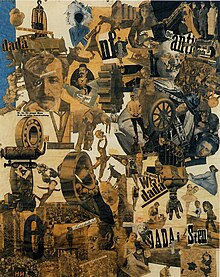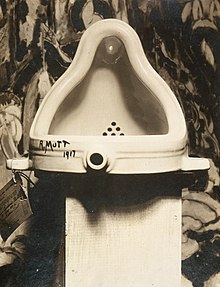Dada
[14] There is no consensus on the origin of the movement's name; a common story is that the artist Richard Huelsenbeck slid a paper knife randomly into a dictionary, where it landed on "dada", a French term for a hobby horse.Key figures in the movement included Jean Arp, Johannes Baader, Hugo Ball, Marcel Duchamp, Max Ernst, Elsa von Freytag-Loringhoven, George Grosz, Raoul Hausmann, John Heartfield, Emmy Hennings, Hannah Höch, Richard Huelsenbeck, Francis Picabia, Man Ray, Hans Richter, Kurt Schwitters, Sophie Taeuber-Arp, Tristan Tzara, and Beatrice Wood, among others.[26] Years later, Dada artists described the movement as "a phenomenon bursting forth in the midst of the postwar economic and moral crisis, a savior, a monster, which would lay waste to everything in its path... [It was] a systematic work of destruction and demoralization...Art historian David Hopkins notes: Ironically, though, Duchamp's late activities in New York, along with the machinations of Picabia, re-cast Dada's history.[27]Dada emerged from a period of artistic and literary movements like Futurism, Cubism and Expressionism; centered mainly in Italy, France and Germany respectively, in those years.In the Dadaist perspective modern art and culture are considered a type of fetishization where the objects of consumption (including organized systems of thought like philosophy and morality) are chosen, much like a preference for cake or cherries, to fill a void.Before World War I, similar art had already existed in Bucharest and other Eastern European cities; it is likely that Dada's catalyst was the arrival in Zürich of artists like Tzara and Janco.These artists along with others like Sophie Taeuber, Richard Huelsenbeck and Hans Richter started putting on performances at the Cabaret Voltaire and using art to express their disgust with the war and the interests that inspired it.At the Cabaret Voltaire we began by shocking common sense, public opinion, education, institutions, museums, good taste, in short, the whole prevailing order.Ball said that Janco's mask and costume designs, inspired by Romanian folk art, made "the horror of our time, the paralyzing background of events" visible."Berlin was a city of tightened stomachers, of mounting, thundering hunger, where hidden rage was transformed into a boundless money lust, and men's minds were concentrating more and more on questions of naked existence...Fear was in everybody's bones" – Richard Hülsenbeck Raoul Hausmann, who helped establish Dada in Berlin, published his manifesto Synthethic Cino of Painting in 1918 where he attacked Expressionism and the art critics who promoted it.Johannes Baader, the uninhibited Oberdada, was the "crowbar" of the Berlin movement's direct action according to Hans Richter and is credited with creating the first giant collages, according to Raoul Hausmann.After the war, the artists published a series of short-lived political magazines and held the First International Dada Fair, 'the greatest project yet conceived by the Berlin Dadaists', in the summer of 1920.Cologne's Early Spring Exhibition was set up in a pub, and required that participants walk past urinals while being read lewd poetry by a woman in a communion dress.During this time Duchamp began exhibiting "readymades" (everyday objects found or purchased and declared art) such as a bottle rack, and was active in the Society of Independent Artists.[51] In an attempt to "pay homage to the spirit of Dada" a performance artist named Pierre Pinoncelli made a crack in a replica of The Fountain with a hammer in January 2006; he also urinated on it in 1993.First performed by the Ballets Russes in 1917, it succeeded in creating a scandal but in a different way than Stravinsky's Le Sacre du printemps had done almost five years earlier.When it was re-staged in 1923 in a more professional production, the play provoked a theatre riot (initiated by André Breton) that heralded the split within the movement that was to produce Surrealism.Van Doesburg mainly focused on poetry, and included poems from many well-known Dada writers in De Stijl such as Hugo Ball, Hans Arp and Kurt Schwitters.), Schwitters read his poems, Vilmos Huszár demonstrated a mechanical dancing doll and Nelly van Doesburg (Theo's wife), played avant-garde compositions on piano.Another Dutchman identified by K. Schippers in his study of the movement in the Netherlands[53] was the Groningen typographer H. N. Werkman, who was in touch with van Doesburg and Schwitters while editing his own magazine, The Next Call (1923–6).For example, when Tristan Tzara was banned from holding seminars in Théâtre Michel in 1923, Iliazd booked the venue on his behalf for the performance, "The Bearded Heart Soirée", and designed the flyer.[56] In Yugoslavia, alongside the new art movement Zenitism, there was significant Dada activity between 1920 and 1922, run mainly by Dragan Aleksić and including work by Mihailo S. Petrov, Ljubomir Micić and Branko Ve Poljanski.Dada's design is primarily monochromatic, and features numerous sharp lines and alternating black and white stripes, in reference to the movement and, in particular, to chessboard and Go patterns.Other notable mentions that do not include the artists below are: Suzanne Duchamp, Elsa von Freytag-Loringhoven, Emmy Hennings, Beatrice Wood, Clara Tice, and Ella Bergmann-Michel.Dadaists used shock, nihilism, negativity, paradox, randomness, subconscious forces, anti-poetry and antinomianism to subvert established traditions in the aftermath of the Great War.Tzara's 1920 manifesto proposed cutting words from a newspaper and randomly selecting fragments to write poetry, a process in which the synchronous universe itself becomes an active agent in creating the art.These movements exerted a pervasive influence on 20th-century music, especially on mid-century avant-garde composers based in New York—among them Edgard Varèse, Stefan Wolpe, John Cage, and Morton Feldman.Some (Otto Freundlich, Walter Serner) died in death camps under Adolf Hitler, who actively persecuted the kind of "degenerate art" that he considered Dada to represent.'"[83] One such example of Duchamp's readymade works is the urinal that was turned onto its back, signed "R. Mutt", titled Fountain, and submitted to the Society of Independent Artists exhibition that year, though it was not displayed.

Second row: Paul Dermée , Philippe Soupault , Georges Ribemont-Dessaignes .
Front row: Tristan Tzara (with monocle), Celine Arnauld , Francis Picabia , André Breton .














Dada (disambiguation)Raoul HausmannHannah HöchJohannes BaaderWieland HerzfeldeGeorge GroszJohn HeartfieldOverviewPrehistoricMedievalGothicRenaissance17th century18th century19th century20th centuryArtists (chronological)ArchitectsPhotographersArt movements (chronological)Salons and academiesImpressionismCubismSurrealismSchool of ParisWestern art historyLouis AragonPaul EluardClément PansaersPaul DerméePhilippe SoupaultGeorges Ribemont-DessaignesTristan TzaraCeline ArnauldFrancis PicabiaAndré Bretonart movementGreat Waranti-artreasonaestheticismcapitalismnonsenseirrationalityanti-bourgeoiscollagesound poetrycut-up writingradical politicsleft-wingfar-left politicsartistic stylemachine aestheticRichard Huelsenbeckpaper knifehobby horseinternationalismMarcel Duchampabstract artFuturistsGerman ExpressionistsUbu RoiAlfred JarryParadeErik SatieHugo BallDada Manifestoliterary journalsJean ArpMax ErnstElsa von Freytag-LoringhovenEmmy HenningsMan RayHans RichterKurt SchwittersSophie Taeuber-ArpBeatrice Wooddowntown musicnouveau réalismepop artFluxusbourgeoisnationalistcolonialistGaleries DalmauDer SturmArmory ShowSVU MánesJack of DiamondsModerne KunstkringFuturismcapitalistaestheticsAmerican Art NewsFirst World WarCabaret Voltairehobbyhorsevisual artsliteraturepoetryart manifestosart theorytheatregraphic designanti-warNew York DadaExpressionismfetishizationNationalgalerie, Staatliche Museen zu BerlincabaretmodernistMarcel JancoArthur SegalVoltaireCandidedogmasSophie TaeuberWorld War Ishock artvaudevilliantabula rasaAfrican musicmanifestomanifestosOctober RevolutionRussia